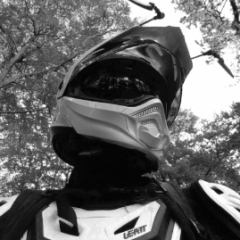-
Posts
17,957 -
Joined
-
Days Won
733
Content Type
Profiles
Blogs
Forums
Gallery
Pipeline Tools
3D Wiki
Plugin List
Store
Downloads
Everything posted by Cerbera
-

How to lock a plane to a pin connected to a gridline?
Cerbera replied to Iseah Osbourne's topic in Cinema 4D
Welcome to Core4D 🙂 The plane doesn't get locked to a pin - it simply defines where world centre is, and therefore where a new object should appear in the scene. Are you saying that this doesn't happen for you ? What happens instead ? Did you have cam calib tag selected when you instantiated new object ? Is there definitely a pin in the scene, and is it in the right place ? CBR -
The thickness parameter in Cloth Surface is animatable, and works fine in all my tests. However, without the scene file we can't know what you may be doing wrong that is making it not work for you. Please upload it. CBR
-
Good plan. HB gives you superb modelling tools that we are only starting to see in native Cinema in very recent versions: Quad-caps, even distribution, surface-aware relax, straighten edges, smooth edges, clip symmetry and of course its immaculate retopo setup, which is based on the shrink-wrap deformer. Pre S26 it was the best 100 quid you could spend in Cinema for the most gain. Even with S26 it remains useful, but not nearly to the same degree... Here is Holger doing some retopo using his HB toolkit... CBR
-
If you have HB modelling bundle, retopo is a breeze and a joy, but even without it Cinema is capable, if not stellar in this area, particularly in latest versions, where we have the relax mode for the brush and magnet tools and we can project poly pen to underlying meshes live as we use it. I can't answer if 3D coat is better for this, never having used it, but the fact that I do retopo pretty much every day, and have never felt the need to leave Cinema to do it must say something... CBR
-
I tell you who has done a tutorial about this for Cinema, and that's Chris Schmidt. It was a very long time ago ( maybe 5 years or so ?) so not sure if it was Greyscale Gorilla or Rocket Lasso, let alone which episode or season of which, but I do recall that he spent most of a whole 2 hour stream trying to sort that out - turned out to be a lot more complicated than he thought ! Perhaps someone else remembers that, and has a GSG sub they can check ? CBR
-
Please upload that file, so we can try all the things... CBR
-

Cloner lights with shared field are not responding correctly
Cerbera replied to Christoph Voorn's topic in Cinema 4D
I do now ! 🙂 I was tired last night, but don't think I missed it - did you add it to the post later ?! Anyway - I see it now - will have a look later when I have finished today's client stuff... CBR -

Cloner lights with shared field are not responding correctly
Cerbera replied to Christoph Voorn's topic in Cinema 4D
Would be helpful to have the scene file ! How are you making a plain effector control light intensity ? CBR -
Please complete your profile to tell us which version of the software you use - very difficult to answer without that information... CBR
- 2 replies
-
- Animation
- Simulation
-
(and 1 more)
Tagged with:
-

Images not being saved automatically during render of animation
Cerbera replied to scifidesigner's topic in Cinema 4D
Well you either mean tokens or takes but it could be either !! Or do you mean to ask OP if he was stoned at the time ? 😉 I have also never come across this error, but am equally powerless to speculate what happened without knowing the scene / project /output settings and the state of the hardware in question. CBR -
I concur, and cannot explain that. Your 'glass' doesn't have thickness as perhaps might be ideal, but that shouldn't make a difference to reflection when there is no transmission, and if I add some I still can't see that sun in the reflection. CBR
-
To be fair Cinema is no slouch in this area either ! Not only can we scatter using cloner multi-instances, vertex maps and fields, but hair can be optimised to render pretty quick too. And if you are up in R25 you have dynamic scatter for placing other plants amongst the grass. I've seen some properly epic fields and pastures done this way... CBR
-
I myself have recently jumped from Octane to RS so this is all a bit new to me too, and the information in the manuals, both on maxon.net and the original RS docs doesn't specifically mention this problem. But I am going to read between the lines and speculate that the RS sky system just doesn't work like the Physical Sky we have in Standard / Physical Renderers in that we can't just specify a color for the sun. The sky setup in RS seems focused mainly on recreating accurate sky models, and so the only influence we seem to have over sun colour is in the Sky Object itself, where we can send it redder or bluer, with 0 being physically accurate. But I disagree we can't see reflections in glass objects. Here is the sun reflecting in a glass sphere ! Apologies for graininess - we are having a heatwave over here, and don't want to melt my computer by rendering for too long in the day ! CBR
-
If the sun is part of a sky system its own color /intensity / atmosphere controls are greyed out, and these things are controlled from within the sky object's sun tab instead I think. CBR
-
I chamfered my edges as well (or rather bevelled them) and that will certainly help to an extent, even though that's not really what cut glass pieces do in the real world (they are actually very sharp edged) ! But you'll just get a lot more out of it if the main faces are slightly varying as well, and as that's as easy as popping a random effector on the cloner, it seems like a no brainer, or at least a very quick thing to try... CBR
-
I don't suppose it's down to the tangent space of the normal map is it - some sort of local vs global space conflict maybe ? I am not expert enough in how these work to be sure, but it seems.... likely ? CBR
-
OK, my strategy for mirrorballing that shape would be to make a grid array of plane objects that you align to the first flat face on your object, then make it editable, connect the pieces into a single mesh, and do a couple of knife cuts along the edges, deleting the polys that remain outside those. If you use the workplane alignment functions you can actually create the plane and cloner pre-aligned to the face in question, which is helpful. Then you can extrude them by a set amount and add a bevel deformer on the parent group. Then you can mirror, symmetry or otherwise transform that plane so you get the other side for free. And then it's just rinse and repeat for every remaining side. I would expect to be able to get that done in about half an hour. This 1 face took about 5 minutes... You can add various effectors before you make the cloner editable if you want a bit more real world randomness in there for example, which will be important for the sparkles, as for the most effectiveness of those you will want every one of the pieces angled subtly differently from its neighbours - if you leave them all exactly planar (as I have done above for illustrative purposes) that very much reduces the effectiveness of the mirror ball look, which is why you mostly see that on spheres.... CBR
-
Ah yes - the old mirrorball dilemma - looks like it's gonna be so easy, and... isn't, if you're doing it right 🙂 I've built a few of the round ones in my time and every time have done it row-by-row then cap sections though you can at least use symmetry to halve the workload. It's not actually that much work if you do that - takes maybe half an hour ? If you want to cover that shape in uniformly regular pieces then you can't use its topology to generate that via any automatic methods because it is obviously not even enough. Unless you Zremesh it more evenly, in which case you might get something usable. So, excepting that, whatever solution you try has to be independent of that topology. We might think of the cloner next, which may be a possibility as far as starting points go, but very unlikely it will be a complete solution on its own. Of course with this base shape, there cannot be squares at the edges unless you want the jaggy outline, so those on the perimeter will have to be trimmed and therefor not square if you want contiguous tiled borders. Difficult to advise further without you being more specific about how you want to tackle those non-planar parts. If I had to do it for a client I would do it by hand, 100% manually so I could get each tile exactly the desired shape and position. I don't know what sort of density of tiles you need, but this is quite a simple shape with a fair amount of repetition, so this task might not be as painful as you think... CBR
-
No ! It isn't in the default interface and doesn't have a shortcut assigned either ! Mystery how you turned that off if you didn't get it from the Modes Menu... CBR
-
Ah OK - yeah same here - just checking you hadn't found some other use for them I was unaware of.... cheers. CBR
-
In what circumstances do you use them, may I enquire ? CBR
-
Yep, that was it - realised it almost immediately after I posted but then had skype call. That's under the Modes / Execution menu in 26. I hate those buttons - they reliably catch me out every few years 🙂 CBR

